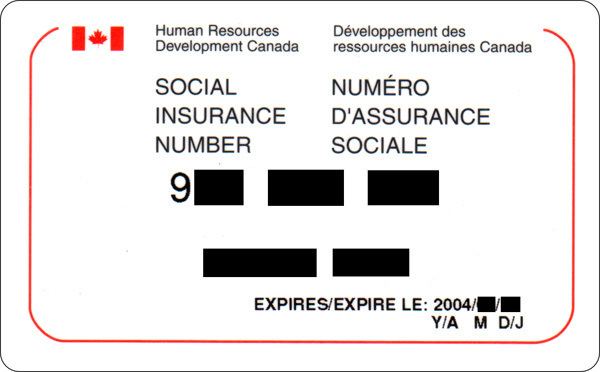 | ||
A social insurance number (SIN) is a number issued in Canada to administer various government programs. The SIN was created in 1964 to serve as a client account number in the administration of the Canada Pension Plan and Canada's varied employment insurance programs. In 1967, Revenue Canada (now the Canada Revenue Agency) started using the SIN for tax reporting purposes. SINs are issued by Human Resources and Skills Development Canada (previously Human Resources Development Canada).
Contents
The SIN is formatted as three groups of three digits (e.g., 123-456-789).
The top of the card has changed over the years as the departments that are responsible for the card have changed:
The 2012 Canadian federal budget contained provisions to phase out the Social Insurance Number cards because they lacked modern security features and could be used for identity theft. As of 31 March 2014, Service Canada no longer issues plastic SIN cards. Instead, an individual will receive a paper "Confirmation of SIN letter".
Functionality
Through functionality creep, the SIN has become a national identification number, in much the same way that the Social Security Number has in the United States. However, unlike in the US, in Canada there are specific legislated purposes for which a SIN can be requested. It is not an identity document.
Unless an organization can demonstrate that the reason it is requesting an individual's SIN is specifically permitted by law, or that no alternative identifiers would suffice to complete the transaction, it cannot deny or refuse a product or service on the grounds of a refusal to provide a SIN. Examples of organizations that legitimately require a SIN include employers, financial institutions that provide interest on deposits, and federal government agencies. Giving a SIN when applying for consumer credit, such as buying a car or electronics, or allowing it to be used as a general purpose identification number, such as by a cable company, is strongly discouraged.
The Canadian military used the SIN as a form of unique identifier from the 1960s until the 1980s, when service numbers were reintroduced. Military identification, including ID cards and identity discs were marked with the SIN during this period.
Temporary SINs
Social Insurance Numbers that begin with the number "9" are issued to temporary residents who are not Canadian citizens or permanent residents (e.g., foreign students, individuals on work visas). Often, these individuals must have an employment authorization in order to work in Canada. SINs beginning with a "9" are different from SINs assigned to citizens and permanent residents, because they have an expiry date (which usually coincides with the expiration of the holder's work permit). These SINs are invalid unless there is an expiry date listed on the card and the date has not passed.
Validation
Social Insurance Numbers can be validated through a simple check digit process called the Luhn Algorithm.
046 454 286 <--- A fictitious, but valid SIN 121 212 121 <--- Multiply each digit in the top number by the digit below it.If the result of this multiplication is a two-digit number, add the digits together and insert the result (the digital root). Thus, in the second-to-last column, 8 multiplied by 2 is equal to 16. Add the digits (1 and 6) together (1 + 6 = 7) and insert the result (7). This can also be achieved by subtracting 9 from the product of the multiplication, ie. 8 multiplied by 2 is equal to 16, 16 - 9 is 7.
So the result of the multiplication is:
086 858 276Then, add all of the digits together:
0+8+6+8+5+8+2+7+6=50If the SIN is valid, this number will be divisible by 10.
Geography
The first digit of a SIN usually identifies the province in which it was registered, as listed below. However, the government has found it necessary in the past to supply certain regions with SIN numbers assigned to other regions.
1: Nova Scotia, New Brunswick, Prince Edward Island, and Newfoundland and Labrador 2–3: Quebec 4–5: Ontario (excluding Northwestern Ontario), and overseas forces 6: Northwestern Ontario, Manitoba, Saskatchewan, Alberta, Northwest Territories, and Nunavut 7: British Columbia and Yukon 8: Not used 9: Temporary resident 0: Newcomers to Canada